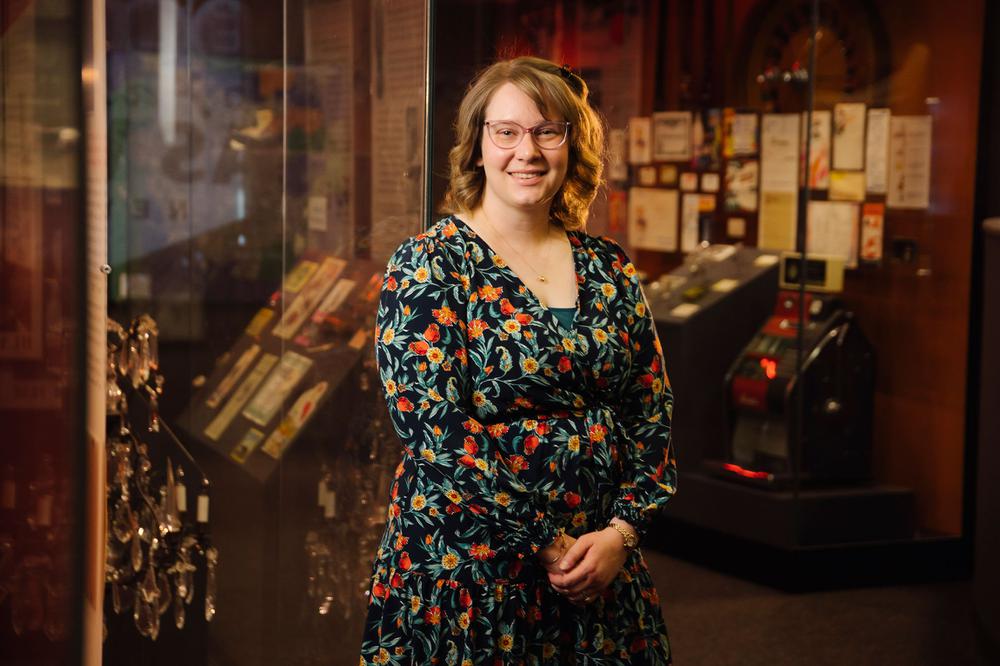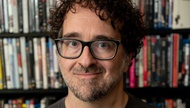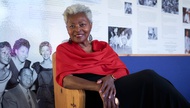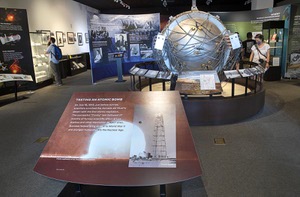At first glance, Maggie Bukowski’s work space might seem fairly typical, lined with filing cabinets, desks and a bookcase. But look closer, and one discovers a trove of timeless maps, letters, newspapers, yearbooks, menus and more, all of which Bukowski preserves and studies as the Nevada State Museum’s new curator of manuscripts, photos and library.Some things immediately stand out, like a map collection dating back to 1847, before Nevada was even a state; or a first-edition copy of Life Among the Paiutes by Sarah Winnemucca Hopkins, the first known autobiography by an indigenous woman, published in 1883. Taken as a whole, all these items add up to a towering monument to the history of the Silver State. We chatted with Bukowski about her job duties and some of the objects in her care.
What is your average day like? I get a lot of phone calls and emails from people wanting information. They may say, “I’ve got this photograph, and I know it’s from Las Vegas. Can you help me identify it?” Or, “I’m writing a book, and I need a photo to illustrate what I’m talking about. Do you have one?”
People also call to say they want to donate something, so we go through the donation process. I look at what they have and make sure it makes sense for our collection. We only collect things Nevada- and Southern Nevada-related … Once things are donated, they’re processed and preserved, so I spend a good deal of time doing that. And then also creating new exhibits, which is my favorite part.
Why? Museums have such large collections, but you don’t put everything on display at once, because there’s too much of it. So it’s very exciting to find something that’s never been put on display before and put it out for people to see. There’s kind of a mystery to it. I feel like Nancy Drew sometimes. I’m like, “What is this? Who wrote it? Why did the museum collect it? How is it important?”
How is an item processed and preserved? Once it comes in, we give it an individual number—like a social security number—so I can track it. Then I’ll input it into our digital database system, so we can find it again and provide access to people. I’ll put [items] in acid-free folders and boxes. We keep them in a temperature- and humidity-controlled environment. We also keep them in the dark. And I limit access to them. If you come in wanting to see an older item, I would have you put on gloves, because the oils from our hands can hurt it.
When did you become interested in history? Really early. My parents and grandparents were all big readers, and my grandmother loved to go to estate sales. I remember, when I was really little, she’d give me a couple of dollars to go buy antiques, and I always thought that was really fun.
How did your time at UNLV prepare you for this job? I have both my bachelor’s and my master’s in American history from UNLV, and while I was a student I worked with the library’s special collections, another specialized library dealing with manuscripts and yearbooks. That was really where I got that hands-on [experience]. Because you can have a lot of theory, but what do you do when something is falling apart?
Are you sometimes surprised by things that make their way into the Nevada State Museum’s collection, like the many October 1 condolence cards that have been donated? I think when people hear “museum,” “manuscript” or “archive,” they’re thinking of old, dusty things from a hundred years ago. October 1 is such a massive part of Las Vegas history—whether we like it or not—that it’s important to collect those. Sometimes we see that things are going to be important, so we’ll try to collect them. Like when the Golden Knights came, we asked people to bring us their Golden Knights stuff, because we knew it was going to be such a big deal. We try to collect with the future in mind.
What are you working on right now? When I was a student at UNLV, I was writing about World War II and the way women in Las Vegas helped in the war effort. I did research at the library, and I came across a manuscript collection by a woman named Barbara Gates, who joined the Women’s Army Auxiliary Corps in 1943. During World War II, there were no females in the military, [but] the U.S. was sending so many men overseas, we needed women to do more jobs. So, they created the WAAC, and Barbara joined. We have a uniform—it wasn’t owned by Barbara; it was owned by another WAAC [worker] who also lived in Las Vegas—but I have Barbara’s papers. She basically wrote all these letters home to her parents in Las Vegas, describing what basic training was like. So, we’re going to put the uniform on a mannequin, and I’m going to pull some of those manuscript letters out. That will be in the window for probably six months, and then I’ll come up with something new and change it up.
What are your longer-term goals? Like most museums, we have a backlog, items that we have but we haven’t fully processed yet. I want to eliminate the backlog, so they’re accessible to everybody. We’re also working on moving our records online. Previously, if you wanted to know what the museum had, you had to call me, email me or come in. Now, every time I write a record it goes up to the cloud, and can go on our website [lasvegasnvmuseum.org] and see what we have. I want everybody to be able to experience all the wonderful stories we have.
Click HERE to subscribe for free to the Weekly Fix, the digital edition of Las Vegas Weekly! Stay up to date with the latest on Las Vegas concerts, shows, restaurants, bars and more, sent directly to your inbox!





